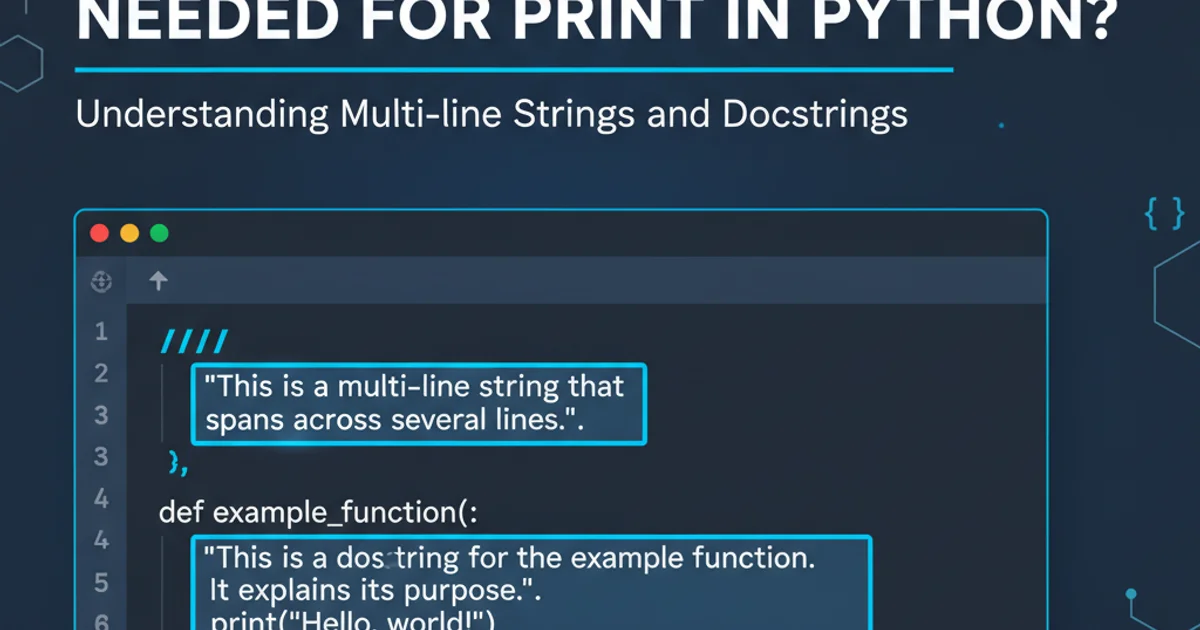Why are three apostrophes needed for print in Python?
Categories:
Understanding Python's Triple Quotes for Strings

Explore why Python uses three apostrophes (or quotation marks) for string literals, their primary use cases, and how they enhance code readability and functionality.
In Python, you'll often encounter strings enclosed in single quotes ('...'), double quotes ("..."), or sometimes, three single quotes ('''...''') or three double quotes ("""..."""). While single and double quotes are generally interchangeable for defining single-line strings, the triple quote syntax serves a distinct and powerful purpose. This article delves into the specific reasons and common applications for using three apostrophes (or quotation marks) in Python.
Multi-line Strings: The Primary Use Case
The most common and fundamental reason for using triple quotes in Python is to define multi-line strings. Unlike single or double quotes, which require explicit newline characters (\n) to span multiple lines, triple-quoted strings automatically preserve line breaks and indentation exactly as they appear in the code. This makes them ideal for creating blocks of text, such as paragraphs, addresses, or formatted output, without cumbersome escape sequences.
single_line_string = 'This is a single-line string.'
# Using \n for multi-line with single quotes
multi_line_escaped = 'This is the first line.\nThis is the second line.'
print(multi_line_escaped)
# Using triple quotes for multi-line
multi_line_triple_quotes = '''
This is the first line.
This is the second line.
This line is indented.
'''
print(multi_line_triple_quotes)
Comparing single-line, escaped multi-line, and triple-quoted multi-line strings.
''' and """ work identically for triple-quoted strings, """ is conventionally preferred for docstrings (documentation strings) as per PEP 257, making it easier to distinguish them from regular string literals.Docstrings: Essential for Code Documentation
Beyond simple multi-line text, triple quotes are indispensable for writing docstrings. Docstrings are special string literals that appear as the first statement in a module, function, class, or method definition. They serve as built-in documentation, accessible via the __doc__ attribute or the help() function, and are crucial for making your code understandable and maintainable. The Python interpreter automatically recognizes these triple-quoted strings as docstrings.
def calculate_area(length, width):
"""Calculate the area of a rectangle.
Args:
length (float): The length of the rectangle.
width (float): The width of the rectangle.
Returns:
float: The area of the rectangle.
"""
return length * width
class Circle:
"""Represents a circle with a given radius.
Attributes:
radius (float): The radius of the circle.
"""
def __init__(self, radius):
self.radius = radius
def get_circumference(self):
"""Calculates the circumference of the circle.
Returns:
float: The circumference.
"""
import math
return 2 * math.pi * self.radius
print(help(calculate_area))
print(Circle.__doc__)
print(Circle.get_circumference.__doc__)
Examples of docstrings for a function, class, and method.
flowchart TD
A[Start]
A --> B{String Definition?}
B -->|Single Line| C[Single/Double Quotes]
B -->|Multi-line Text| D[Triple Quotes]
B -->|Docstring| D
D --> E[Preserves Line Breaks & Indentation]
D --> F[Accessible via __doc__ / help()]
C --> G[No Line Break Preservation]
E --> H[End]
F --> H
G --> HDecision flow for choosing string literal types in Python.
Embedding Quotes within Strings
Another subtle advantage of triple quotes is their ability to seamlessly embed single or double quotes within the string without needing to escape them. This can simplify string construction, especially when dealing with text that naturally contains various quotation marks, such as JSON snippets, HTML, or natural language sentences.
message_single_quotes = 'He said, "Hello!"'
message_double_quotes = "She replied, 'Hi there.'"
# Using triple quotes to avoid escaping
json_data = '''
{
"name": "Alice",
"age": 30,
"city": "New York"
}
'''
print(json_data)
html_content = """
<div class="container">
<h1>Welcome</h1>
<p>This is a 'sample' paragraph.</p>
</div>
"""
print(html_content)
Embedding quotes and complex structures using triple-quoted strings.
''' inside a '''...''' string), you would still need to escape the inner triple quotes to prevent premature termination of the string.